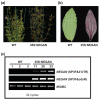Transcriptional control of floral anthocyanin pigmentation in monkeyflowers (Mimulus)
- PMID: 25103615
- PMCID: PMC4221532
- DOI: 10.1111/nph.12968
Transcriptional control of floral anthocyanin pigmentation in monkeyflowers (Mimulus)
Abstract
A molecular description of the control of floral pigmentation in a multi-species group displaying various flower color patterns is of great interest for understanding the molecular bases of phenotypic diversification and pollinator-mediated speciation. Through transcriptome profiling, mutant analyses and transgenic experiments, we aim to establish a 'baseline' floral anthocyanin regulation model in Mimulus lewisii and to examine the different ways of tinkering with this model in generating the diversity of floral anthocyanin patterns in other Mimulus species. We find one WD40 and one bHLH gene controlling anthocyanin pigmentation in the entire corolla of M. lewisii and two R2R3-MYB genes, PELAN and NEGAN, controlling anthocyanin production in the petal lobe and nectar guide, respectively. The autoregulation of NEGAN might be a critical property to generate anthocyanin spots. Independent losses of PELAN expression (via different mechanisms) explain two natural yellow-flowered populations of M. cardinalis (typically red-flowered). The NEGAN ortholog is the only anthocyanin-activating MYB expressed in the M. guttatus flowers. The mutant lines and transgenic tools available for M. lewisii will enable gene-by-gene replacement experiments to dissect the genetic and developmental bases of more complex floral color patterns, and to test hypotheses on phenotypic evolution in general.
Keywords: MYB-bHLH-WD40; anthocyanin pigmentation; autoregulation; flower color; monkeyflowers (Mimulus); natural variation; phenotypic evolution.
© 2014 The Authors. © 2014 The Authors New Phytologist © 2014 New Phytologist Trust.
Figures










Similar articles
-
The regulatory network for petal anthocyanin pigmentation is shaped by the MYB5a/NEGAN transcription factor in Mimulus.Genetics. 2021 Feb 9;217(2):iyaa036. doi: 10.1093/genetics/iyaa036. Genetics. 2021. PMID: 33724417 Free PMC article.
-
An R2R3-MYB transcription factor regulates carotenoid pigmentation in Mimulus lewisii flowers.New Phytol. 2016 Feb;209(3):1049-57. doi: 10.1111/nph.13647. Epub 2015 Sep 17. New Phytol. 2016. PMID: 26377817
-
Competition between anthocyanin and flavonol biosynthesis produces spatial pattern variation of floral pigments between Mimulus species.Proc Natl Acad Sci U S A. 2016 Mar 1;113(9):2448-53. doi: 10.1073/pnas.1515294113. Epub 2016 Feb 16. Proc Natl Acad Sci U S A. 2016. PMID: 26884205 Free PMC article.
-
Anthocyanins in Floral Colors: Biosynthesis and Regulation in Chrysanthemum Flowers.Int J Mol Sci. 2020 Sep 7;21(18):6537. doi: 10.3390/ijms21186537. Int J Mol Sci. 2020. PMID: 32906764 Free PMC article. Review.
-
Monkeyflowers (Mimulus): new model for plant developmental genetics and evo-devo.New Phytol. 2019 Apr;222(2):694-700. doi: 10.1111/nph.15560. Epub 2018 Nov 24. New Phytol. 2019. PMID: 30471231 Review.
Cited by
-
MtGSTF7, a TT19-like GST gene, is essential for accumulation of anthocyanins, but not proanthocyanins in Medicago truncatula.J Exp Bot. 2022 Jun 24;73(12):4129-4146. doi: 10.1093/jxb/erac112. J Exp Bot. 2022. PMID: 35294003 Free PMC article.
-
Two transcription factors TaPpm1 and TaPpb1 co-regulate anthocyanin biosynthesis in purple pericarps of wheat.J Exp Bot. 2018 Apr 27;69(10):2555-2567. doi: 10.1093/jxb/ery101. J Exp Bot. 2018. PMID: 29562292 Free PMC article.
-
Floral color is not as simple as it once seemed.Sci Adv. 2022 Sep 16;8(37):eade2347. doi: 10.1126/sciadv.ade2347. Epub 2022 Sep 14. Sci Adv. 2022. PMID: 36103523 Free PMC article. Review.
-
RNA-seq-based evaluation of bicolor tepal pigmentation in Asiatic hybrid lilies (Lilium spp.).BMC Genomics. 2016 Aug 11;17(1):611. doi: 10.1186/s12864-016-2995-5. BMC Genomics. 2016. PMID: 27516339 Free PMC article.
-
Rosa1, a Transposable Element-Like Insertion, Produces Red Petal Coloration in Rose Through Altering RcMYB114 Transcription.Front Plant Sci. 2022 Apr 29;13:857684. doi: 10.3389/fpls.2022.857684. eCollection 2022. Front Plant Sci. 2022. PMID: 35574133 Free PMC article.
References
-
- Albert NW, Lewis DH, Zhang H, Schwinn KE, Jameson PE, Davies KM. Members of an R2R3-MYB transcription factor family in Petunia are developmentally and environmentally regulated to control complex floral and vegetative pigmentation patterning. Plant Journal. 2011;65:771–784. - PubMed
-
- Baudry A, Caboche M, Lepiniec L. TT8 controls its own expression in a feedback regulation involving TTG1 and homologous MYB and bHLH factors, allowing a strong and cell-specific accumulation of flavonoids in Arabidopsis thaliana. Plant Journal. 2006;46:768–779. - PubMed
-
- Beardsley PM, Yen A, Olmstead RG. AFLP phylogeny of Mimulus section Erythranthe and the evolution of hummingbird pollination. Evolution. 2003;57:1397–1410. - PubMed
Publication types
MeSH terms
Substances
Grants and funding
LinkOut - more resources
Full Text Sources
Other Literature Sources

